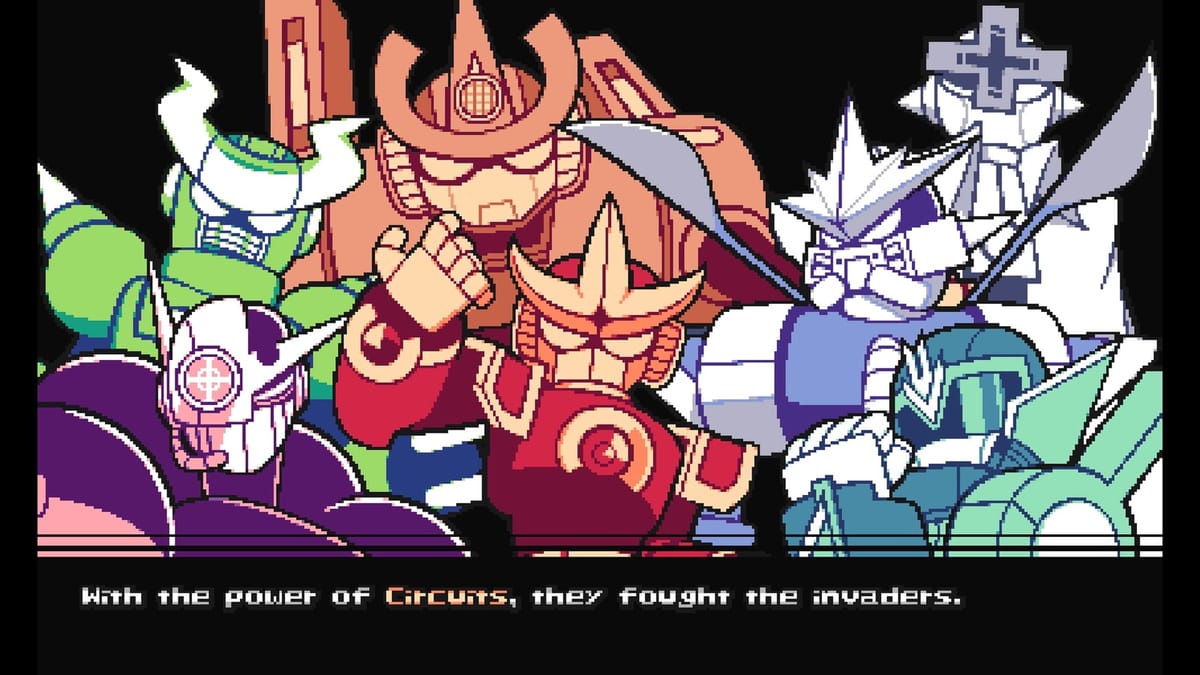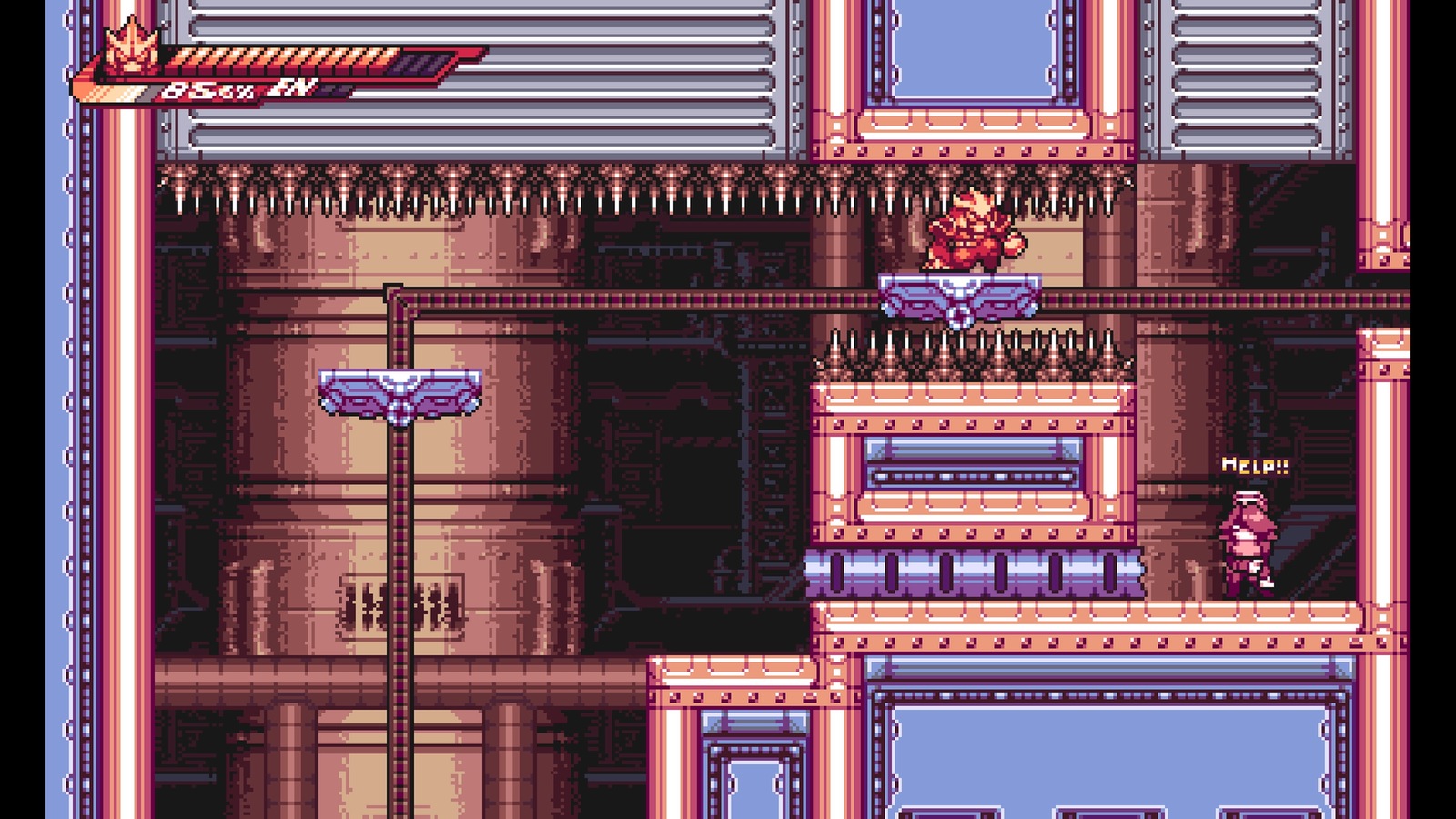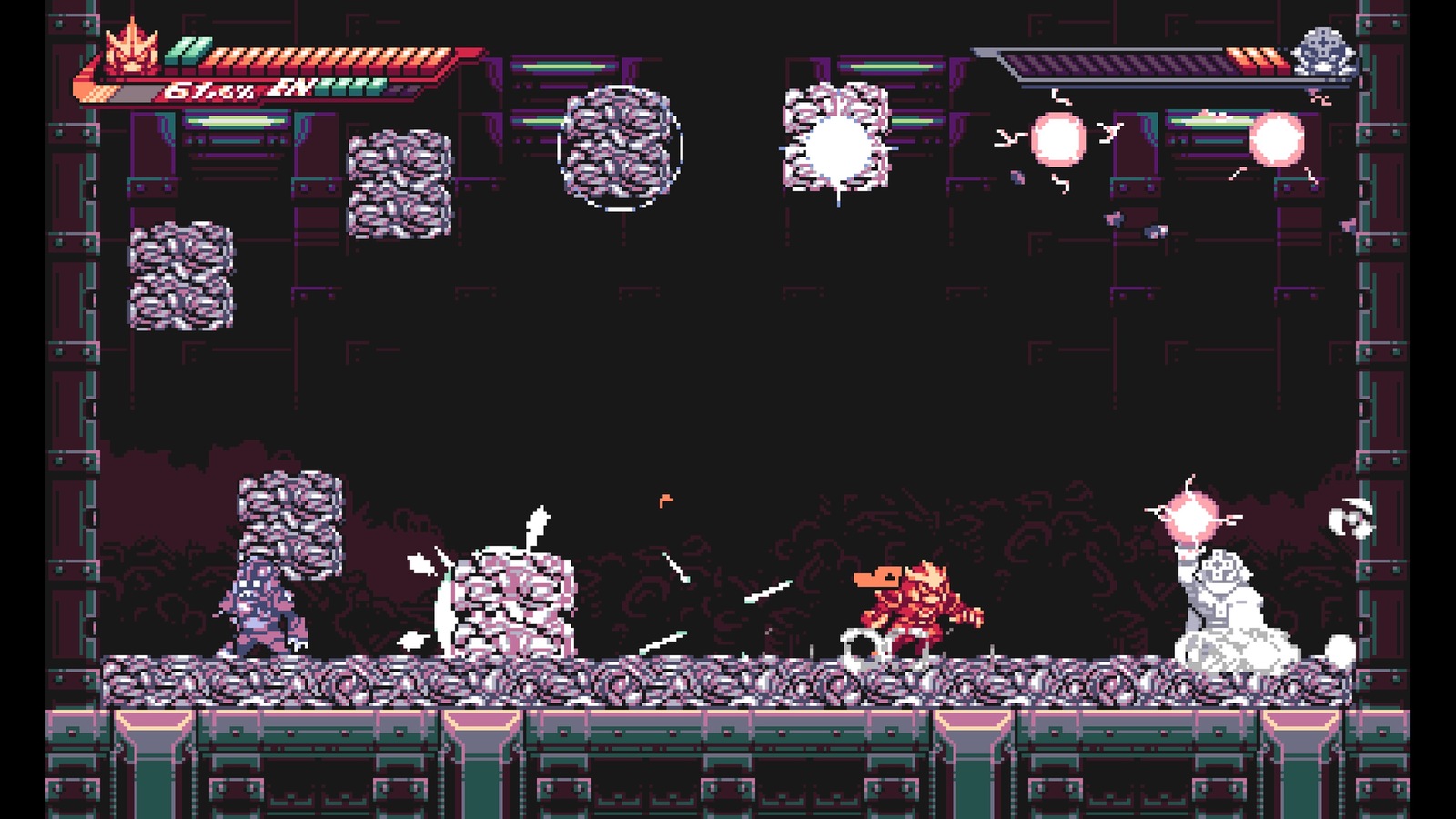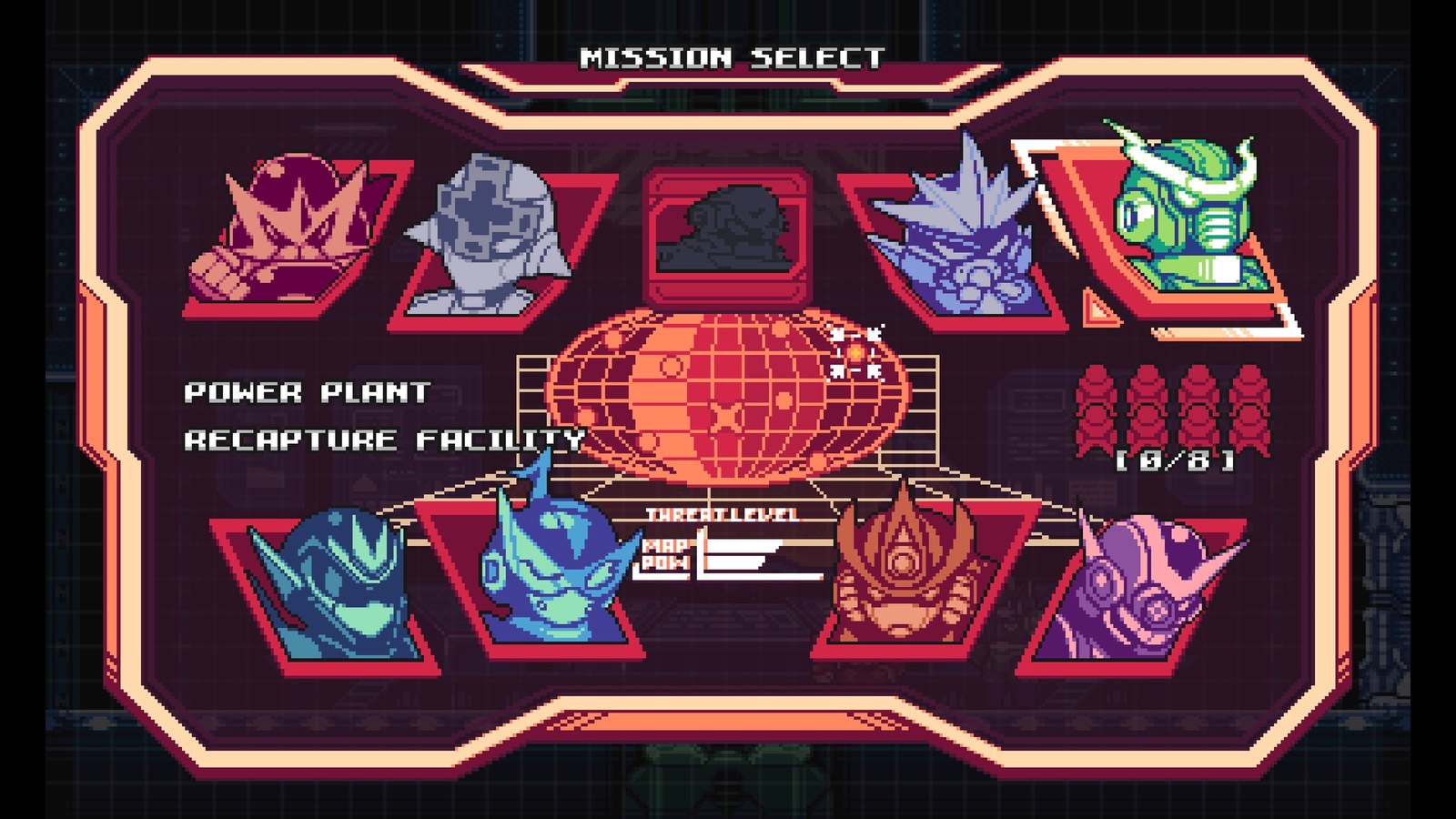
I see platformers as games about caution. Looking before you leap proves vital not only to your success, but also in discovering what makes these games fun. Platformers dramatize equivalents to crossing a busy street or hiking a trail in real life by exaggerating the danger. They transform mundane traversal into an artform that thrills in the moment and satisfies in retrospect. As a result, many platformers rely on a calculated pace that works best when you take your time.
While you can certainly play Gravity Circuit that way and enjoy it, I’d argue that’s not what makes it fun. Caution weighs the experience down. Gravity Circuit shines brightest when you throw caution to the wind.
This realization struck me as I was about halfway through my second playthrough of the game. On my first run (more of a brisk walk, really), I took my time. I approached each obstacle with caution, killed every enemy, and combed through every stage to ensure that I didn’t miss any secrets. I enjoyed my trepidatious treks, but they felt off, almost restrained. Gravity Circuit’s game mechanics screamed out for more. Upon my second go-round, I broke out into a mad dash, rushing past enemies while barrelling towards the end of the stage. Despite doing decidedly less exploration, I nevertheless found the truth: Gravity Circuit’s fun lies in this faster, more aggressive style of play.
The nature of Gravity Circuit’s combat asks that you slow down. Many platformers involving robots revolve around shooting enemies from a distance. This approach allows you to start and finish fights before you come into contact with them, allowing skilled players to maintain their pace. Gravity Circuit’s robot specializes in punches and kicks, which requires you to get right up into an enemy’s personal space before attacking. Your only ranged attack comes in the form of a grappling hook, which also requires a clear line of sight to the enemy. This often means that you have little choice except to stop and wail whatever bad guy blocks your path with multiple blows until you can move forward.
Admittedly, the wailing is excellent. Although Gravity Circuit never truly leaves its platformer roots, the presentation of its combat mimics the best of arcade fighters and beat-em-ups. Every attack in Gravity Circuit effectively sells the strength and intensity with crunchy sounds and animations. Beating on enemies provides a consistent source of joy.
You can have too much of a good thing, however. When the stop-and-start nature of the combat combines with an abundance of enemies, the pacing starts to suffer. Fighting every enemy requires a lot of stopping. These roadblocks further compound with the fact that Gravity Circuit contains some devious platforming challenges that will further tempt you to stop in your tracks. Not only that, you’ll often be checking your surroundings for breakable walls hiding optional platforming challenges that further extend the length of each level.
While I enjoyed each element of Gravity Circuit individually, I found that they came together in a way that made each level drag on longer than it “should.” Before you know it, you find yourself in the video game equivalent of a traffic jam. You can’t help when there’s a lot of cars on the road. At the end of the day, however, no one likes being stuck in traffic. We’ve all got places to be and things to do if only everyone else would just get the heck out of our way.
Perhaps more cars should invest in grappling hooks. Although the basic combat of Gravity Circuit slows you down, that’s not the whole story. Most of Gravity Circuit’s mechanics emphasize speed – the most obvious one being a dash. A more cautious player may hesitate to rely on the dash without knowing what’s ahead; by my second playthrough I basically never stopped holding down the button. The grappling hook primarily functions as a way to cross long gaps found over conveniently placed ceilings, yet its true power lies in situations where you don’t necessarily need it. With careful maneuvering, you can skip chunks of levels or fly overhead enemies.
Similarly, combat doesn’t have to stop you in your tracks for as long as it seems. The grapple hook latches onto enemies just as well as the environment. If they’re weak enough, you can hold them in the palm of your robotic hands. From there, you can toss incapacitated foes at subsequent ones, doing massive damage that often bypasses the need for any fisticuffs. Your options further expand through an arsenal of unlockable super moves that quickly demolish foes and keep up your momentum when properly utilized.
By combining all of these techniques, Gravity Circuit transforms dramatically. I knew how these mechanics worked on my initial playthrough, but I didn’t fully appreciate them. My eyes were too focused on the potential dangers and secrets ahead. I didn’t want to miss anything, so I proceeded with caution to my own detriment. That approach results in a cool and often interesting game, but one that wears out its welcome. The better game is the one where you gracefully flow through levels, dishing out devastating blows only when needed, as you speedily dash to your final destination. The true Gravity Circuit requires that you stab caution with your grappling hook and toss it to the wind.
Obviously I would not have stuck around for a second playthrough to learn all of this if the first one didn’t make an impression. Gravity Circuit features some truly slick presentation in terms of its art and sound direction.
The boss battles demonstrate the strengths of both the presentation and the game mechanics. They put on a show (sometimes literally) of spectacle and a genuine test of skill. Dodging attacks requires a speedy pace Fights like these provide the best opportunity to let all of your special attacks loose into devastating combos that hurl your foe all over the screen. After a successful battle, I was often tempted to save a clip and watch the fight back. When you avoid taking much damage, these battles result in some impressive choreography.
About the only issue I take with these fights is how bosses will briefly become invulnerable if you damage them too quickly. This limits just how crazy you can get with your offense at any given time. While I understand that this likely prevents every fight from becoming trivial, this is not a particularly graceful solution. It comes across like the game has to actively cheat on your enemy’s behalf in order to prolong the battle. I would prefer that the game lean into its strengths and make the bosses stronger to accommodate the limits of your abilities.
Put simply, Gravity Circuit is a distinctively cool game. That it maintains that distinctive quality is impressive because it wears its inspirations on its sleeve. When games do that, they risk coming across as uninspired. Much like jumping through Gravity Circuit’s levels, the caution that comes from reverence can limit a game’s true potential. Gravity Circuit takes a lot of obvious inspirations from other platformers, yet molds them into part of a greater distinct identity. This blend of old and new lets it punch above its weight.
Stop me if you’ve heard this one before: eight evil bad guys appear to do eight evil things, and you can take them out in any order. Each victory grants you the opportunity to get new abilities, and once you’ve defeated all of the bad guys, you need to defeat the baddest guy at his bad guy fortress. If you told me to stop, I couldn’t hear you. I already wrote the paragraph, sorry.
While Gravity Circuit adopts the Mega Man premise wholeheartedly, it executes on the details distinctly. All of your extra abilities are completely optional and don’t rely on preying on your enemy’s weaknesses. The melee focus separates itself from Mega Man’s blaster or even melee-focused Mega Man characters like Zero. Gravity Circuit’s protagonist lands his blows with a snappiness that allows him to quickly weave in and out of danger. His grappling hook acts as a driving force for interesting approaches – you’re constantly thinking about how you avoid enemies or use your foes as resources.
These ideas give the sensation that you’re constantly reacting and making do with whatever happens to be on-hand. There’s a wildness to Gravity Circuit that contrasts with the more calculated style that Mega Man games typically embody, even when playing them efficiently. It may look like Mega Man at glance, but Gravity Circuit doesn’t feel like Mega Man to play. Maybe Gravity Circuit didn’t need to borrow from the Mega Man at all, but it doesn’t prevent the game from carving out its own niche. For games like this, I think that’s the best case scenario.
Gravity Circuit
Great
Gravity Circuit (grapple) hooked me after I threw caution to the wind. First playthroughs inherently emphasize caution, which means that truly appreciating the game will take some time. If you’re willing to put in the effort, you’ll find a game that twists old ideas in a fresh and fun direction.
Pros
- Satisfyingly slick presentation
- Distinctive approach to Mega Man stylings
- Cool grapple hook
Cons
- Caution bogs down the game
- Boss safeguards can restrict the combat





